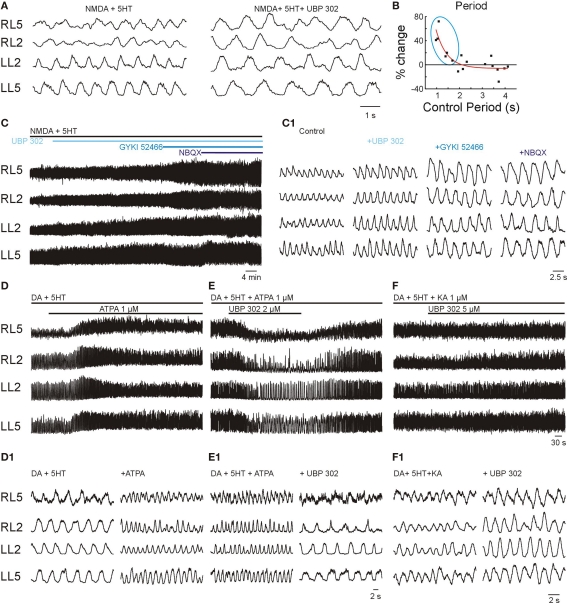Figure 5.
Kainate receptor activation contributes to speed regulation. VR activity was recorded in AC mode for RL2/RL5 and in DC mode for LL2/LL5. (A) High frequency locomotor-like activity elicited by NMDA-5HT was reduced in frequency by UBP 302 (5 μM). (B) Plot of the UBP 302-induced difference in the locomotor period (% change with respect to control) as a function of the control period. Note the significant increase in the period at high frequencies (control frequency > 0.6 Hz; blue ellipse; n = 6, ***p < 0.005), but the lack of effects at lower frequencies (n = 11). (C) Cumulative effect of different non-NMDAR antagonists, UBP 302 (5 μM), GYKI 52466 (20 μM) and NBQX (10 μM) on 5HT/NMDA induced locomotor-like activity. The VR recording configuration was as in (A). (C1) Details of the effects of non-NMDAR blockade on bursts amplitude and frequency of locomotor-like activity. (D) Activation of GluR5s increased the locomotor frequency. ATPA (0.3–2 μM), a specific GluR5 KAR agonist, increased the frequency of locomotor-like activity initiated by standard concentrations of 5HT-DA, n = 5, p < 0.02. (D1) Expansions show VR activity before and after full effect of ATPA. (E) ATPA-mediated acceleration of the locomotor rhythm was specifically blocked by bath application of the GluR5 antagonist UBP-302 (1–3 μM). (E1) Expansions show VR activity before and after full effect of UBP 302. (F) Bath application of UBP 302, at even higher doses than used to suppress ATPA effects (5–12 μM) only partially reduces the frequency of the locomotor-like activity initiated by the broad spectrum non-NMDAR agonist KA (together with the standard concentrations of 5HT-DA). (F1) Expansion shows VR activity before and after full effect of UBP 302.

